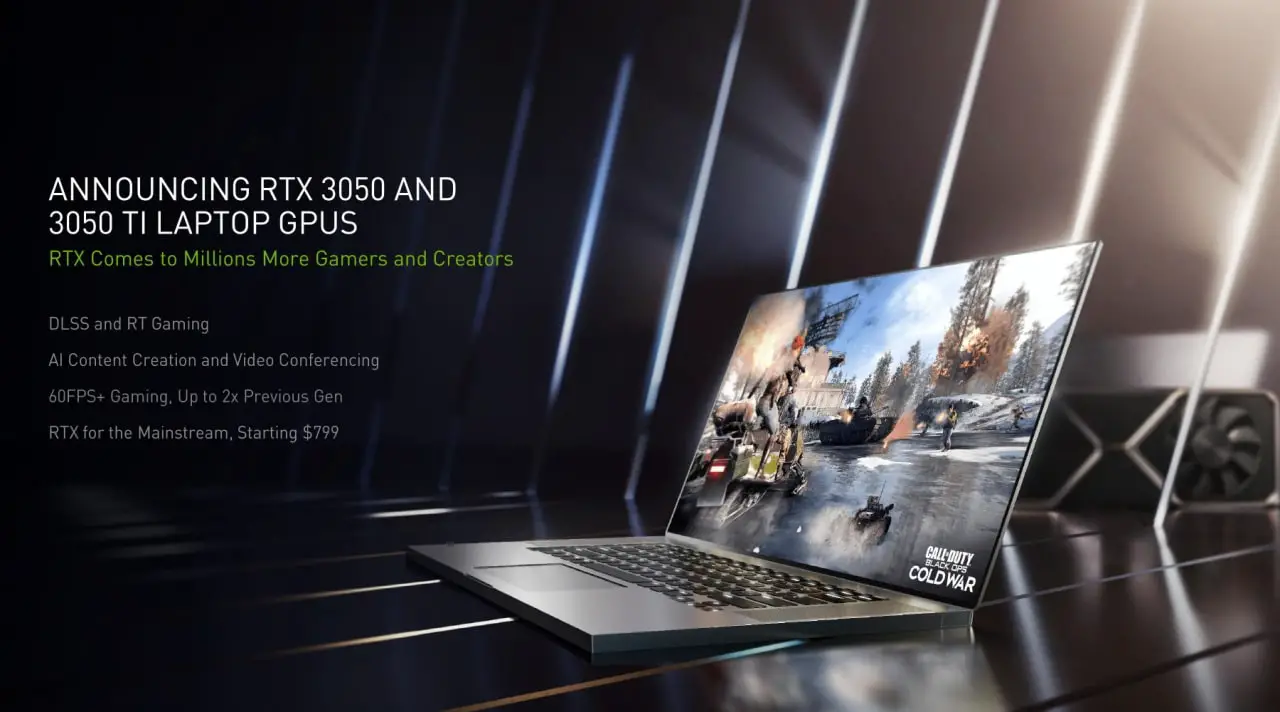Earlier this year, Nvidia began rolling out the “Ampere” -based Geforce RTX 3000 series for laptops. These were Geforce RTX 3080, Geforce RTX 3070 and Geforce RTX 3060 in 28 different variants, where parameters such as current budget, clock frequencies and memory amount varied greatly depending on the type of circuit in question.
The company is now expanding its range of laptops with two more graphics solutions. These are the Geforce RTX 3050 and RTX 3050 Ti, where both models will make it possible to build affordable laptops with support for DirectX 12 Ultimate, with, among other things, hardware-accelerated ray tracing and upscaling via Nvidia’s DLSS technology.
Specifications: Geforce RTX 3000 series for laptops
RTX 3080 | RTX 3070 | RTX 3060 | RTX 3050 Ti | RTX 3050 | |
|---|---|---|---|---|---|
Technical | 8nm Samsung | 8nm Samsung | 8nm Samsung | 8nm Samsung | 8nm Samsung |
Circuit | GA104 | GA104 | GA106 | GA107 | GA107 |
Architecture | Ampere | Ampere | Ampere | Ampere | Ampere |
CUDA cores | 6 144 st. | 5 120 st. | 3 840 st. | 2 560 st. | 2 048 st. |
Texture units | 192 st. | 160 st. | 120 st. | 80 st. | 64 st. |
Raster units | 96 st. | 96 st. | 64 st. | 48 st. | 40 st. |
Tensor cores | 192 st. | 160 st. | 120 st. | 80 st. | 64 st. |
RT cores | 48 st. | 40 st. | 30 st. | 20 st. | 16 st. |
Clock frequency | – | – | – | – | – |
GPU Boost | 1 245–1 710 MHz | 1 290–1 620 MHz | 1 283–1 703 MHz | 1 035–1 695 MHz | 1 057–1 740 MHz |
Computational power | 15 298–21 012 GFLOPS | 13 209–16 589 GFLOPS | 9 853–13 079 GFLOPS | 5 299–8 678 GFLOPS | 4 329–7 127 GFLOPS |
Memory bus | 256-bit | 256-bit | 192-bit | 128-bit | 128-bit |
Memory amount | 16/8 GB GDDR6 | 8 GB GDDR6 | 6 GB GDDR6 | 4 GB GDDR6 | 4 GB GDDR6 |
Memory frequency | 14 000 MHz | 14 000 MHz | 12 000–14 000 MHz | 12 000 MHz | 12 000–14 000 MHz |
Memory bandwidth | 448 GB/s | 448 GB/s | 288–336 GB/s | 192 GB/s | 192–224 GB/s |
TGP | 80–150 W+ | 80–125 W | 60–115 W | 35–80 W | 35–80 W |
Both newcomers are based on the fresh graphics circuit GA107, which will be the smallest so far in the “Ampere” family. Geforce RTX 3050 Ti does not quite unexpectedly get a more full-scale version of the circuit, where we see 2,560 CUDA cores, 80 Tensor cores and 20 RT cores. The graphics memory amounts to 4 GB GDDR6 which runs at a speed of 12,000 MHz while the nominal turbo frequency of the graphics circuit varies between 1,035 and 1,695 MHz depending on which power budget the circuit has been configured according to.
For the Geforce RTX 3050, the circuit is reduced to 2,048 CUDA cores, which are accompanied by 64 Tensor cores and 16 RT cores. Again, 4 GB of GDDR6 memory is visible, but this time at varying speeds between 12,000 MHz and 14,000 MHz depending on the power budget. Like its big brother, the circuit can be configured according to a power range of 35 and 80 W – a parameter that in practice affects the clock frequencies that the graphics circuit can achieve, and thus the actual game performance.
In terms of performance, Nvidia aims for gaming at 1080p with both graphics solutions, where the company claims a 50 percent increase in frame rate for the Geforce RTX 3050 Ti when compared to the Geforce GTX 1650 Ti in pure raster performance. Not entirely unexpectedly, however, the emphasis is mostly on performance ray tracing and DLSS enabled – two technologies not supported by the Geforce GTX 1650 Ti. It is not clear from the presentation which version of the Geforce RTX 3050 Ti is used in terms of power budget.
Nvidia Geforce RTX 3050 Ti and RTX 3050 for laptops are expected to be available in ready-made configurations during the month of May. According to Nvidia, computers with the new graphics solutions will start at price tags from USD 799 or the equivalent of SEK 8,400 including VAT.















